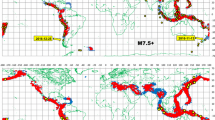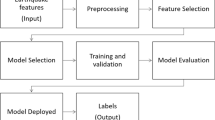Abstract
Earthquake prediction is one of the challenging problems of seismology. The present study intended to setup a routine prediction of major earthquakes in the Iranian plateau using a modification of the intermediate-term middle-range algorithm M8, in which original version has demonstrated high performance in a real-time Global Test over the last two decades. An investigation of earthquake catalog covering the entire the Iranian plateau through 2012 has shown that a modification of the M8 algorithm, adjusted for a rather low level of earthquake occurrence reported in the region, is capable for targeting magnitude 7.5+ events. The occurrence of the April 16, 2013, M7.7 Saravan and the September 24, 2013, M7.7 Awaran earthquakes at the time of writing this paper (14 months before Saravan earthquake occurrence) confirmed the results of investigation and demonstrated the need for further studies in this region. Earlier tests, M8 application in all over the Iran, showed that the 2013 Saravan and Awaran earthquakes may precede a great earthquake with magnitude 8+ in Makran region. To verify this statement, the algorithm M8 was applied once again on an updated catalog to September 2013. The result indicated that although the study region recently experienced two magnitude 7.5+ earthquakes, it remains prone to a major earthquake. The present study confirms the applicability of M8 algorithm for predicting earthquakes in the Iranian plateau and establishes an opportunity for a routine monitoring of seismic activity aimed at prediction of the largest earthquakes that can play a significant role in mitigation of damages due to natural hazard.








Similar content being viewed by others
References
Aghanabati A., 2004, Geology of Iran. Ministry of Industry and Mine, Geological Survey of Iran Press 2004
Allen CR, Edwards W, Hall WJ, Knopoff L, Raleigh CB, Savit CH, Toksoz MN, Turner RH 1976, Predicting earthquakes: a scientific and technical evaluation, with implications for society. Panel on Earthquake Prediction of the Committee on Seismology, Assembly of Mathematical and Physical Sciences. National Research Council, U.S. National Academy of Sciences, Washington, DC
Allen M, Jackson J, Walker R (2004) Late Cenozoic reorganization of the Arabia-Eurasia collision and the comparison of short-term and long-term deformation rates. Tectonics 23:TC2008
Ambraseys N, 2009, Earthquakes in the eastern Mediterranean and the Middle East: a multidisciplinary study of 2000 years of seismicity, Cambridge Univ. Press pp. 968. (ISBN 9780521872928)
Ambraseys NN, Melville CP (1982) A history of Persian earthquakes. Cambridge University Press, Britain
Berberian M (1976) Contribution to the seismotectonics of Iran, part II. Geological Survey of Iran 39:518
Berberian M (1977) Contribution to the seismotectonics of Iran, part III. Geological & Mineral Survey of Iran 40:300
Berberian M, 1981, Active faulting and tectonics of Iran. In: Gupta, H.K., Delany, F.M. (Eds.), Zagros-Hindu Kush-Himalaya geodynamic evolution. American Geophysical Union, Geodynamics Series Volume 3, American Geophysical Union, pp. 33 ± 69
Byrne DE, Sykes LR, Davis DM (1992) Great thrust earthquakes and aseismic slip along the plate boundary of the Makran subduction zone. J Geophys Res 97(B1):449–478
Davis C, Keilis-Borok V, Kossobokov V, Soloviev A (2012) Advance prediction of the March 11, 2011 Great East Japan earthquake: a missed opportunity for disaster preparedness. International Journal of Disaster Risk Reduction 1:17–32. doi:10.1016/j.ijdrr.2012.03.001
Dobrovolsky IR, Zubkov SI, Myachkin VI (1979) Estimation of the size of earthquake preparation zone. Pure Appl Geophys 117:1025–1044
Grando G, and McClaly K 2006 Morphotectonics domains and structural styles the Makran accretionary prism, offshore Iran, Sedimentary Geology,23 pages.
Healy JH, Kossobokov VG, and Dewey JW, 1992 A test to evaluate the earthquake prediction algorithm, M8, U.S. Geol. Surv. Open-File Report 92–401, 23 p. with 6 Appendices
Hough S 2009 Predicting the unpredictable: the tumultuous science of earthquake prediction. Princeton University Press, 272 pages
Jacob KH, and Quittmeyer RC, 1979, The Makran region of Pakistan and Iran trencharc system with active plate subduction. Geodaynamic of Pakistan, pp.397–412
Keilis-Borok VI (1990) The lithosphere of the earth as a nonlinear system with implications for earthquake prediction. Rev Geophys 28:19–34
Keilis-Borok VI, Kossobokov VG 1984 A complex of longterm precursors for the strongest earthquakes of the world. Proc. 27th Geological Congress vol. 61. Nauka, Moscow, pp. 56–66
Keilis-Borok VI, Kossobokov VG 1987 Periods of high probability of occurrence of the world’s strongest earthquakes. Computational Seismology vol. 19. Allerton Press, pp. 45–53
Keilis-Borok VI, and Kossobokov VG (1988) Premonitory activation of seismic flow: algorithm M8. Lecture Notes of the Workshop on Global Geophysical Informatics with Applications to Research in Earthquake Prediction and Reduction of Seismic Risk (15 Nov.–16 Dec., 1988), ICTP, Trieste, 17 p
Keilis-Borok VI, Kossobokov VG (1990) Premonitory activation of seismic flow: algorithm M8. Phys Earth Planet Inter 61:73–83
Keilis-Borok VI, Soloviev A 2003 Nonlinear dynamics of the lithosphere and earthquake prediction, Springer, ISSN 0172-7389
Keilis-Borok VI, Knopoff L, Rotvain IM, Sidorenko TM (1980) Bursts seismicity as long-term precursors of strong earthquake. J Geophys Res 85:803–811
Kossobokov VG (1986) The test of algorithm M8. In: Sadovsky MA (ed) Algorithms of long-term earthquake prediction. CERESIS, Lima, Peru, pp 42–52
Kossobokov VG 1997 User manual for M8. In: Healy, J.H., Keilis-Borok, V.I., Lee, W.H.K. (Eds.), Algorithms for earthquake statistics and prediction, IASPEI Software Library vol. 6. Seismol. Soc. Am., El Cerrito, CA
Kossobokov VG (2011) Are mega earthquakes predictable? Izvestiya, Atmospheric and Oceanic Physics 46(8):951–961
Kossobokov VG (2013) Earthquake prediction: 20 years of global experiment. Nat Hazards 69:1155–1177. doi:10.1007/s11069-012-0198-1
Kossobokov V (2014) Chapter 18. Times of increased probabilities for occurrence of catastrophic earthquakes: 25 years of hypothesis testing in real time. In: Wyss M, Shroder J (eds) Earthquake hazard, risk, and disasters. Elsevier, London, pp 477–504
Kossobokov VG, Healy JH, Dewey JW (1997) Testing an earthquake prediction algorithm. Pure Appl Geophys 149:219–232
Kossobokov VG, Romashkova LL, Keilis-Borok VI, Healy JH (1999b) Testing earthquake prediction algorithms: statistically significant advance prediction of the largest earthquakes in the Circum-Pacific, 1992–1997. Phys Earth Planet Inter 111:187–196
Kossobokov VG, Romashkova LL, Panza GF, Peresan A (2002) Stabilizing intermediate-term middle-range earthquake predictions. J Seismol Earthq Eng 8:11–19
Memarian H (2008) Structural geology. University of Tehran Press 2008, 866p
Mojarab M, Memarian H, Zare M (2015a) Performance evaluation of the M8 algorithm to predict M7+ earthquakes in Turkey. Arab J Geosci 8:5921. doi:10.1007/s12517-014-1624-3
Mojarab M, Kossobokov V, Memarian H, Zare M (2015b) An application of earthquake prediction algorithm M8 in eastern Anatolia at the approach of the 2011 Van earthquake. J Earth Syst Sci 124:1047. doi:10.1007/s12040-015-0584-7
Page WD, Alt JN, Cluff LS, Plafker G (1979) Evidence for the recurrence of large magnitude earthquakes along the Makran Coast of Iran and Pakistan. Tectonophysics 52:533–547
Peresan A, Kossobokov V, Romashkova L, Panza GF (2005) Intermediate-term middle-range earthquake predictions in Italy: a review. Earth Sci Rev 69:97–132
Shebalin PN 1992 Automatic duplicate identification in set of earthquake catalogues merged together. Open-File Rep. U.S. Geol. Surv., 92–401 (Appendix II)
Silverman BW (1986) Density estimation for statistics and data analysis. Chapman and Hall, New York, p 76 equation 4.5
Author information
Authors and Affiliations
Corresponding author
Appendix 1. Completeness and continuity of catalogs
Appendix 1. Completeness and continuity of catalogs
It is of crucial importance to determine the space of reliable calculations as well as the completeness and continuity of the input data catalog before applying any prediction algorithm. The earthquake catalog of the Iranian plateau and Makran region are selected from the USGS/NEIC Global Hypocenters database system at latitudes from 20° to 50° N and longitudes from 33° to 75° E and at latitudes of 20° to 40° N and longitudes of 50° to 70° E, respectively. The analysis of the cumulative distribution of earthquake frequency versus years indicated that there is a continued set of data from about 1970 up until present for the Iranian plateau (Fig. 9). Before this turning point (i.e., 1970), there were several fluctuations of moderate size in cumulative time series in both catalogs. The Gutenberg–Richter graphs (Fig. 10a, b) also indicate that the magnitude completeness of our catalogs for both the Iranian plateau and the Makran region is 4.6 and more. Therefore, it could be concluded that the M8 algorithm targeting magnitude 7.5+ and 8+ is applicable in these two territories.
The Gutenberg–Richter plots for the area under study (from 1970 to 2013). a The Iranian plateau. b Makran region. The triangles represent the annual number of earthquakes in a certain magnitude bin, and the squares represent the cumulative number of earthquakes summed from higher magnitude ranges. Possible choices of the magnitude of completeness are indicated with a dash line. Both catalogs are complete for magnitude 4.6
1.1 Appendix 2. Application of the modified M8 algorithm to the Makran region.
Tables 5, 6, 7, and 8 present the results of the application of the modified M8 algorithm to the region. The first column in the tables present the number of CI; second and third columns—coordinates of the CI center; and columns 4 to 19—the half year ahead of the data used for the modified M8 execution. In each row, green cells with number (1) and red cells with number (−1) are TIPs and failure to run the modified M8, respectively; cells with number (0) corresponds that M8 was run but no TIP diagnosed.
Rights and permissions
About this article
Cite this article
Mojarab, M., Memarian, H., Zare, M. et al. Adjusting the M8 algorithm to earthquake prediction in the Iranian plateau. J Seismol 21, 921–940 (2017). https://doi.org/10.1007/s10950-017-9644-6
Received:
Accepted:
Published:
Issue Date:
DOI: https://doi.org/10.1007/s10950-017-9644-6






